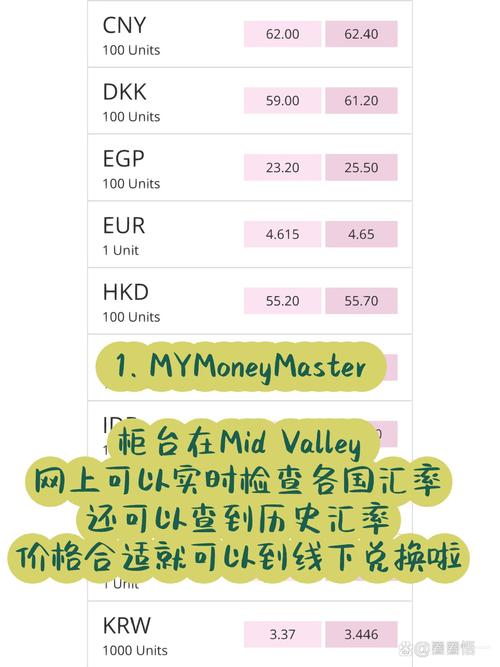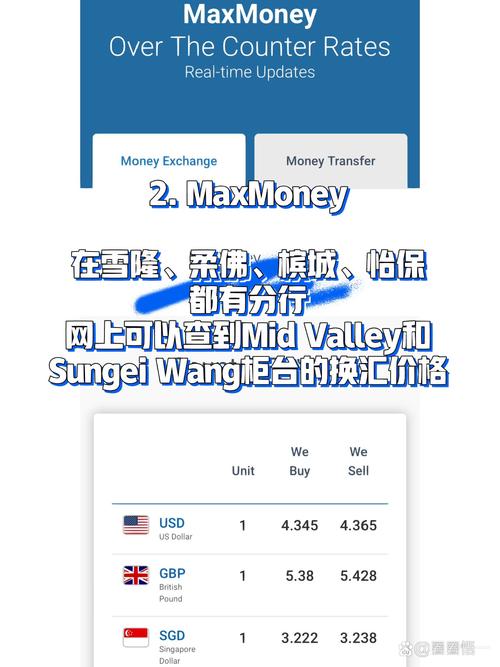How to Make Money Using Exchange Rates
Exchange rates fluctuate constantly, and savvy individuals can capitalize on these fluctuations to make money. Whether you’re a beginner or an experienced trader, understanding how to make money using exchange rates is crucial. In this article, we’ll explore various methods and strategies to help you get started.
Understanding Exchange Rates
Exchange rates represent the value of one currency in terms of another. For example, if the exchange rate between the US dollar (USD) and the Euro (EUR) is 1.10, it means that 1 USD is equivalent to 1.10 EUR. Fluctuations in exchange rates occur due to various factors, such as economic indicators, political events, and market sentiment.

1. Currency Trading
Currency trading, also known as forex trading, is one of the most popular ways to make money using exchange rates. Here’s how you can get started:
-
Open a forex trading account: Choose a reputable broker and open an account. Ensure that the broker offers a user-friendly platform and competitive fees.
-
Learn the basics: Familiarize yourself with forex trading terminology, such as pips, lots, leverage, and margin. Understand how to read a currency chart and identify trends.
-
Develop a trading strategy: Create a plan based on your risk tolerance and investment goals. You can use fundamental analysis (studying economic indicators) or technical analysis (studying price charts) to make informed decisions.

-
Start trading: Once you’re confident in your strategy, start trading. Remember to manage your risk by setting stop-loss and take-profit levels.
2. Currency Arbitrage
Currency arbitrage involves taking advantage of price discrepancies in different markets. Here’s how you can do it:
-
Identify price discrepancies: Look for currency pairs with significant price differences in different markets. For example, if the exchange rate for USD/EUR is 1.10 in one market and 1.12 in another, there’s an opportunity for arbitrage.
-
Execute trades: Buy the currency at the lower price and sell it at the higher price. This will result in a profit from the price difference.
-
Be quick: Arbitrage opportunities are often short-lived, so it’s essential to act quickly.
3. Currency Options
Currency options provide a way to speculate on the future direction of exchange rates without owning the actual currency. Here’s how you can get started:
-
Understand options: Learn about call and put options, as well as strike prices and expiration dates. Options can be used to hedge against currency risk or speculate on exchange rate movements.
-
Choose a broker: Find a broker that offers currency options trading. Ensure that the broker has a user-friendly platform and competitive fees.
-
Develop a strategy: Create a plan based on your risk tolerance and investment goals. Options can be used for both short-term and long-term trading.
-
Start trading: Once you’re confident in your strategy, start trading options. Remember to manage your risk by setting stop-loss and take-profit levels.
4. Currency Futures
Currency futures are contracts to buy or sell a specific amount of currency at a predetermined price and date. Here’s how you can get started:
-
Understand futures: Learn about futures contracts, margin requirements, and expiration dates. Futures can be used to hedge against currency risk or speculate on exchange rate movements.
-
Choose a broker: Find a broker that offers currency futures trading. Ensure that the broker has a user-friendly platform and competitive fees.
-
Develop a strategy: Create a plan based on your risk tolerance and investment goals. Futures can be used for both short-term and long-term trading.
-
Start trading: Once you’re confident in your strategy, start trading futures. Remember to manage your risk by setting stop-loss and take-profit levels.
5. Diversify Your Portfolio
Investing in a diversified portfolio of currencies can help mitigate risk and potentially increase your returns. Here’s how you can diversify your portfolio:

